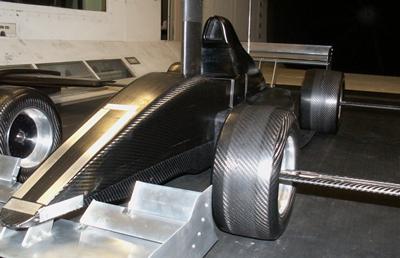The University has played a key role in the development of Formula 1 racing over several decades, and continues to provide world-leading research, development, consultancy and teaching for the industry.

The University helped pioneer the rolling road wind tunnel, the tool of choice for race and sports car development. Advanced wind tunnel technology developed here provided facilities and expertise for several UK Formula 1 teams in the 1980s and 1990s. Formula 1 World championship-winning cars were developed here for Brabham, Tyrell, and Williams.
Penske developed their cars at Southampton from 1987 to 2003, including the PC-23 that took an unprecedented first three places at the Indy 500 in 1994. The University is still recognised as a leader in ground effect aerodynamics, and continues to work with a number of Formula 1 teams for research, development and consultancy. The Ferrari A1GP car, World Rally teams, and sports cars have all been developed at the University.
A sustained PhD programme over the past decade, sponsored by several F1 teams, has resulted in seminal works on, for example, front wings and diffusers in ground effect, wheel aerodynamics, design optimisation, and CFD and wind tunnel correlation techniques. Within the last decade these PhD graduates have gone on to be part of, and lead, aerodynamics teams in F1 teams including McLaren, Mercedes GP, Renault GP, Red Bull Racing, Sauber, Force India, and Virgin Racing.
A prime example of the impact of the University in Formula 1 is the career of engineering alumnus Adrian Newey. Adrian is widely regarded as the best Formula 1 designer in the business and led Red Bull Racing’s engineering team to victory with a car that was the ‘class of the field’ in 2010.
Graduating in 1980 with a BSc in Aeronautics and Astronautics, Adrian’s undergraduate project was designing a sports car in the wind tunnel used by today’s students on the same course.
The Red Bull development team that Adrian led last year included graduates from the unique Race Car Aerodynamics MSc and extensive PhD programme, and current students on placement with the team also contributed while still studying for their degrees.
Red Bull Racing is not unique in this respect. The University probably provides more aerodynamicists to Formula 1 than any other in the world, with one of its graduates on almost every F1 team on the grid. Teams regularly compete for students. In early 2011, four leading Formula 1 teams emailed the University directly, to recruit our students for one-year placements.
The MSc in Race Car Aerodynamics is a unique programme aimed at graduates and similarly qualified individuals from engineering, scientific or mathematical backgrounds, who want advanced specialisation in race car aerodynamics. It was created in response to discussions with Formula 1 teams, and to meet their need for more highly qualified aerodynamicists. Emphasis is placed on the fundamentals of the subject, which include analysis, computation and measurement of turbulent flows associated with high-performance race cars.
Research projects covering theoretical, computational or experimental research are carried out each year, many of which are in conjunction with race teams – either on campus, or at their factories. Other taught elements include guest lectures from leading race team technical directors and chief aerodynamicists. Graduates are highly sought after in the Formula 1 industry.